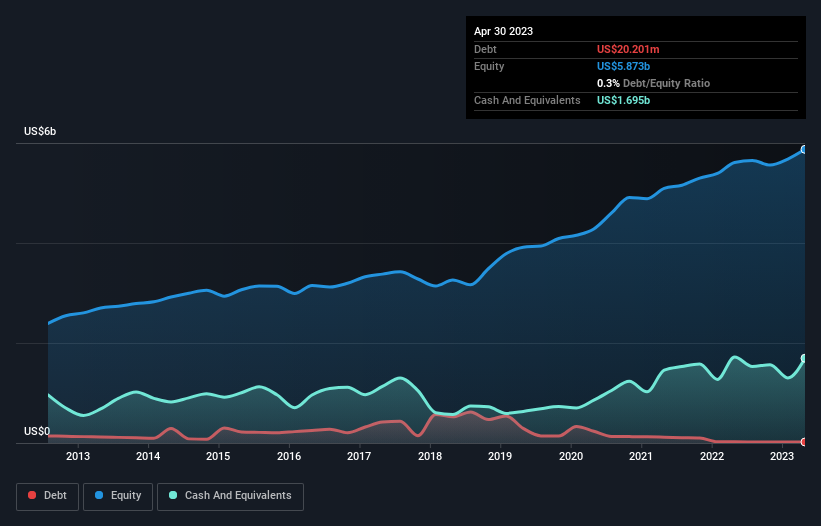
Legendary fund manager Li Lu (who Charlie Munger backed) once said, 'The biggest investment risk is not the volatility of prices, but whether you will suffer a permanent loss of capital.' So it seems the smart money knows that debt - which is usually involved in bankruptcies - is a very important factor, when you assess how risky a company is. We can see that Synopsys, Inc. (NASDAQ:SNPS) does use debt in its business. But should shareholders be worried about its use of debt?
When Is Debt Dangerous?
Debt and other liabilities become risky for a business when it cannot easily fulfill those obligations, either with free cash flow or by raising capital at an attractive price. Ultimately, if the company can't fulfill its legal obligations to repay debt, shareholders could walk away with nothing. However, a more usual (but still expensive) situation is where a company must dilute shareholders at a cheap share price simply to get debt under control. Of course, plenty of companies use debt to fund growth, without any negative consequences. The first thing to do when considering how much debt a business uses is to look at its cash and debt together.
Check out our latest analysis for Synopsys
How Much Debt Does Synopsys Carry?
As you can see below, Synopsys had US$20.2m of debt at April 2023, down from US$23.8m a year prior. However, it does have US$1.70b in cash offsetting this, leading to net cash of US$1.68b.

How Healthy Is Synopsys' Balance Sheet?
We can see from the most recent balance sheet that Synopsys had liabilities of US$2.75b falling due within a year, and liabilities of US$1.17b due beyond that. Offsetting these obligations, it had cash of US$1.70b as well as receivables valued at US$1.03b due within 12 months. So its liabilities total US$1.19b more than the combination of its cash and short-term receivables.
Having regard to Synopsys' size, it seems that its liquid assets are well balanced with its total liabilities. So while it's hard to imagine that the US$66.3b company is struggling for cash, we still think it's worth monitoring its balance sheet. Despite its noteworthy liabilities, Synopsys boasts net cash, so it's fair to say it does not have a heavy debt load!
On the other hand, Synopsys saw its EBIT drop by 9.5% in the last twelve months. If earnings continue to decline at that rate the company may have increasing difficulty managing its debt load. The balance sheet is clearly the area to focus on when you are analysing debt. But it is future earnings, more than anything, that will determine Synopsys's ability to maintain a healthy balance sheet going forward. So if you're focused on the future you can check out this free report showing analyst profit forecasts.
But our final consideration is also important, because a company cannot pay debt with paper profits; it needs cold hard cash. Synopsys may have net cash on the balance sheet, but it is still interesting to look at how well the business converts its earnings before interest and tax (EBIT) to free cash flow, because that will influence both its need for, and its capacity to manage debt. Over the last three years, Synopsys actually produced more free cash flow than EBIT. There's nothing better than incoming cash when it comes to staying in your lenders' good graces.
Summing Up
While it is always sensible to look at a company's total liabilities, it is very reassuring that Synopsys has US$1.68b in net cash. And it impressed us with free cash flow of US$1.5b, being 145% of its EBIT. So we don't think Synopsys's use of debt is risky. The balance sheet is clearly the area to focus on when you are analysing debt. But ultimately, every company can contain risks that exist outside of the balance sheet. To that end, you should be aware of the 1 warning sign we've spotted with Synopsys .
If, after all that, you're more interested in a fast growing company with a rock-solid balance sheet, then check out our list of net cash growth stocks without delay.
New: Manage All Your Stock Portfolios in One Place
We've created the ultimate portfolio companion for stock investors, and it's free.
• Connect an unlimited number of Portfolios and see your total in one currency
• Be alerted to new Warning Signs or Risks via email or mobile
• Track the Fair Value of your stocks
Have feedback on this article? Concerned about the content? Get in touch with us directly. Alternatively, email editorial-team (at) simplywallst.com.
This article by Simply Wall St is general in nature. We provide commentary based on historical data and analyst forecasts only using an unbiased methodology and our articles are not intended to be financial advice. It does not constitute a recommendation to buy or sell any stock, and does not take account of your objectives, or your financial situation. We aim to bring you long-term focused analysis driven by fundamental data. Note that our analysis may not factor in the latest price-sensitive company announcements or qualitative material. Simply Wall St has no position in any stocks mentioned.
About NasdaqGS:SNPS
Synopsys
Provides electronic design automation software products used to design and test integrated circuits.
Flawless balance sheet with solid track record.


